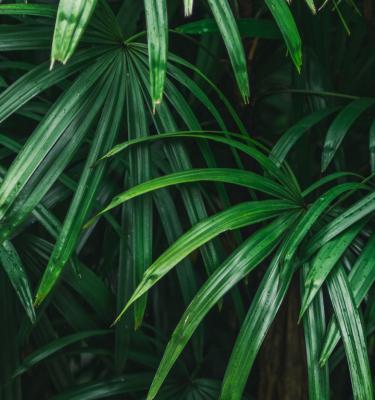

How to grow & care for a Kentia Palm
Kentia Palms (Howea forsteriana) are tall, elegant palms with arching fronds on long stems that will happily grow as a houseplant or outdoors in the right spot. Kentia Palm trees are one of the best plants for beginner gardeners as they survive on neglect and are very low maintenance.
Kentia Palms are native to Lord Howe Island - which has a subtropical climate - so they prefer a moist, but not soggy soil and they like a humid environment. You can mist the leaves regularly, group them with other plants or use a humidifier to give them the conditions they prefer.
In their natural habitat a Kentia Palm can grow up to 3 metres tall. Indoors it’s unlikely to reach this height, but it will still grow to a substantial height and they make a great feature plant.
Top 5 steps to growing a Kentia Palm
- A Kentia Palm prefers a spot with medium to bright indirect light - direct afternoon sun can burn their leaves. If growing them outdoors choose a part to dappled morning sunlight to full shade spot.
- If growing in pots use a premium, like Scotts Osmocote Premium Potting Mix for Indoor Plants to give your plant the best start possible
- Kentia Palms like a moist, but free draining soil. Make sure the pot has drainage holes and don’t allow water to collect in saucers or the base of cover pots.
- Fertilise Kentia Palms with an indoor plant fertiliser like Scotts Osmocote Pour+Feed for Indoor Plants once a month during spring and summer, to encourage strong healthy growth.
- Kentia Palms prefer an environment away from drying drafts from heaters or air conditioners. Mist the leaves regularly or position it in a naturally humid spot like a bathroom or kitchen.
Shopping List
- A Kentia Palm
- If growing in a pot
- If growing in the ground
- A potting mix scoop or garden trowel
- Defender Pyrethrum Insect Spray
Growing in a pot
Choose a pot for your Kentia Palm that’s roughly 2 times the size of the original nursery pot - make sure it has drainage holes or use a black plastic pot that sits snuggly inside a cover-pot or cache pot (pot with no holes).
Half fill your pot with Scotts Osmocote Premium Potting Mix for Indoor Plants and gently remove the Kentia Palm from the nursery pot and position it into the potting mix, backfill around root ball with more potting mix so that the potting mix is level with, or slightly below, the top of the pot.
Water your new Kentia Palm in well and tip out any excess water from the base of the cover-pot or saucer (if using). Kentia Palms prefer a moist soil that is never soggy and they are ready to be watered once the top 2-3cm of potting mix is dry to the touch. Never let water pool in the base of cover-pots or in saucers as your Kentia Palm will quickly rot if their potting mix remains soggy or waterlogged.
Growing in the garden
Kentia Palms can be grown outside in a warm, frost free spot. Choose a shady spot or dappled morning sunlight spot with a rich, moist but free-draining soil. Kentia Palms like a high humidity environment, so they’ll benefit from being planted amongst other ferns or plants to create a humid environment.
Dig the hole twice as wide as the original nursery pot and the same depth. Mix some Scotts Osmocote Compost Premium Soil Improver through the soil at the bottom of the whole.
Remove your Kentia Palm from its pot and position it into the middle of the hole, backfill around the root ball with soil and water your new plant in well.
Mulch around your in ground Kentia Palm to retain moisture and suppress weeds. They’ll need regular watering particularly during warm or dry weather.
Fertilising & Care
Fertilise Kentia Palms fortnightly in spring and summer with an indoor plant fertiliser to encourage new growth. Use Scotts Osmocote Pour+Feed for Indoor Plants - this is a simple to use ‘measure and pour’ feed which contains the right balance of nutrients. If you’d prefer a longer term fertilising product, with less applications, apply Scotts Osmocote Controlled Release Fertiliser for Indoor Plants in early spring and again in early autumn - this product feeds for up to 6 months.
Fertilise in ground planted Kentia Palms with Scotts Osmocote Controlled Release Fertiliser: All Purpose in spring and again in early autumn.
In the warmer months of spring and summer Kentia Palms will appreciate a more regular watering and a higher humidity. To increase the humidity around Kentia Palms, group them with other plants to create a microclimate or mist them with a spray bottle regularly. You can also sit their pot on a saucer filled with pebbles and water - as the water evaporates it will humidify the air.
Remove any dead or damaged fronds at the base to promote new growth. To remove the dust that collects on Kentia Palm leaves, pop it into the shower or bring it outside for a gentle hose off or use a soft, damp cloth to remove stubborn dust gently.
Pests & Diseases
Indoor Kentia Palms are most susceptible to scale, mites and mealybugs - regularly check at the base of fronds and the backs of the leaves for signs of these pests - use Defender Pyrethrum Insect Spray to control them if needed.
Yellowing leaves on your Kentia Palm could indicate excess watering - only water when the top 2-3cm of potting mix or soil feel dry.
Browning leaves on a Kentia Palm could be a sign of not enough water or too much direct sunlight. Increase watering if the soil feels dry or relocate your Kentia Palm to a more shaded position.



